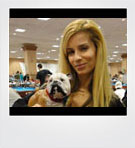 My last article covered 5 of the 10 silliest mistakes players make in nine ball. Here are the other 5.
My last article covered 5 of the 10 silliest mistakes players make in nine ball. Here are the other 5.
1. Do not add speed to the cue ball to play tight shape onto a pocket hanger.
Examples:
a) You are shooting the eight and the nine ball is hanging over a pocket. Good position, in this case, would be anywhere on the table. It would be especially foolish to add speed to the cue ball when you shoot the eight just to try to get near the nine.
b) You are shooting the three, and the four is hanging in the pocket with the five nearby. If position is easily achieved on the five regardless of where you land on the four, it would be a bad idea to add speed in an attempt to play tight to the four.
The exception to this rule is when you have to play long position off the hanger. In that situation, getting close to the hanging object ball is advantageous as it allows you a better chance at judging both the speed and the precision of the angle when you shoot it.
2. Do not chance snookering yourself to get tight shape on a hanger. You must settle for the sure thing in this case.
There are times when it is chancy to try to get near a ball that is hanging over a pocket because other balls are in or near your position path. As in the mistake above, the exception is when long position is needed off the hanger. Still, you must weigh the increased risk of snookering yourself against the reward that tight position offers before making your choice on how to make the shot.
3. Do not play kicks that have a scratch written all over them. When the object ball at which you kick is near a pocket, you must be mindful of the chance of having the cue ball carom into the pocket for a scratch.
Sometimes you can try to hit the "safe side" of the object ball to avoid the scratch, other times the "safe side" may be unavailable. When this is the case, look for a different way to kick at the ball. If you do not see one, consider tying something up.
4. Do not duck (defense without snookering) near loose balls or clusters. Too often you leave a simple safe.
5. Early in the rack, do not attempt a tough kick (30% or less) when a failure to make the hit may sell out the nine ball, especially if there is a way to break up the combo. Late in the rack you usually have to go for the kick, as you can rarely afford to give up ball in hand with only a few balls left.
These are mistakes that great players take years to learn, and I had the good fortune of finding a mentor who taught them to me and shaved years off my learning curve. I hope these principles help advance your game as much as they did mine.
- Home
- Pooldawg Academy
- Jennifer Barretta
- avoid making silly mistakes in 9 ball pt 2
Avoid Making Silly Mistakes in 9 Ball (Pt 2)
Posted by : Jennifer Barretta